Cart
Your cart is empty
ALFREDO DE BENEDICTIS FOUNDER | HAIRSTYLIST

Alfredo De Benedictis is an Italian-British hair stylist and salon owner with over 40 years of experience. Since 1989, his passion for innovation has led him to create groundbreaking hair tools that minimize stress on the hair while delivering flawless results. From the iconic Rootpermer and Wellformer of the ’90s to the global hit Babyliss Curl Secret, Alfredo’s mission remains the same—developing tools that protect hair health without compromising style.
Your scalp is the foundation for healthy hair - think of it as soil for plants. When it's dry, irritated, clogged with buildup or lacks nutrients, hair growth suffers. A well-cared-for scalp promotes stronger, shinier, and healthier hair. Let’s explore how to keep it in top shape!
An itchy or dry scalp can have many causes and understanding the root of the issue is key to treating it effectively.
First, your scalp might be dry and itchy for several reasons:
Environmental Factors:
Product Sensitivity & Lifestyle:
Medical & Hormonal Causes:
If you're experiencing persistent flaking, hair loss, or scalp discomfort, it’s best to consult your GP or a trichologist for personalised treatment and peace of mind.
Cold Weather & Scalp Sensitivity:
Avoid heading out with wet hair in cold or damp conditions. Wear a hat to protect your scalp from temperature extremes that can lead to dryness and irritation.
Sunburn:
Burning your scalp is common as most people neglect it when applying sunscreen. As with other sunburn, a sunburnt scalp will redden and be hot to the touch, itchy and flakey. Severe sunburn can cause blisters and lead to sunstroke. Aloe vera will soothe the irritation and promote healing.
You can protect your hair and scalp from sun damage by using a made-for-hair sun care protector, such as Coola Daily Protect Scalp Mist SPF30, covering your scalp from the sun and adopting protective hairstyles such as a top bun or braids.
The symptoms you experience could help you diagnose the cause of your itchy/flaky scalp.
Common signs include:
To keep your follicles in optimal condition, you need the right care routine based on your scalp’s unique needs. You should cleanse your scalp with the right products for its needs. If your hair is prone to turning greasy quickly, look for clarifying shampoos and scalp scrubs that deliver a follicle-unclogging deep clean. If you find that your hair is dry and that your scalp sometimes feels tight, turn towards hydrating formulas that contain nourishing oils.
| Scalp Concern | How to Take Care |
|---|---|
| Oily Scalp | Use a gentle clarifying shampoo, avoid over-washing, and try scalp exfoliation. |
| Sunburned Scalp | Apply aloe vera, wear a hat outdoors, and use SPF-infused hair products. |
| Itchy Scalp | Avoid harsh shampoos, use tea tree oil, and try scalp massages with anti-inflammatory oils. |
| Dry, Sensitive Scalp | Opt for sulfate-free shampoos, use hydrating masks, and avoid hot water. |
| Dry, Flaky Scalp | Exfoliate weekly, use a moisturizing scalp serum, and drink plenty of water. |
| Winter Scalp Care | Increase hydration, use oil treatments, and protect scalp from harsh weather. |
Small lifestyle changes can significantly improve scalp health. Here’s what you can do:
Hydration & Nutrition
Scalp Care Routine
Stress & Hormonal Balance
Think of your scalp as the foundation of healthy hair. If it’s out of balance, your hair will struggle too.
The top beauty experts in the world – hair stylists, colourists, trichologists and dermatologists – all agree that if your scalp is off-kilter, you’re likely to experience issues with your hair, too.
The skin all over your body has millions of hair follicles, each producing at least one strand of hair. The follicles rely on the skin’s oil-producing sebaceous glands. While the hair follicles on our arms, legs and faces tend to produce short, fine hairs, the scalp contains thousands of hair follicles that produce thick, long hairs. If these hair follicles are blocked, dry or irritated, the health of the hair they grow can be impacted. Your hair may become drier, more brittle and more prone to breakage. Hair growth can become impeded, resulting in increased hair fall and thinning.
For our hair follicles to grow healthy strands, our scalps should be kept clean and hydrated without becoming too oily and free from irritation-causing conditions such as dermatitis and dandruff. It is easier said than done, but there are some things you can do to help.
Whether it's in a spa, in your regular shampoo and conditioner, or made from ingredients in your fridge, there are some fantastic scalp treatments to alleviate common scalp issues.
Best Scalp Treatments for Common Issues:
Natural Ingredients:
These nourish, strengthen, and support long-term scalp health:
Pharmaceutical Ingredients:
These target specific scalp conditions:
Myth: Washing your hair less often is better for your scalp.
Truth: It depends on your hair type, lifestyle, and product use. Infrequent washing can cause buildup and irritation, especially for oily scalps.
Myth: An oily scalp means you don’t need hydration.
Truth: Oil and hydration are different. An oily scalp can still be dehydrated, leading to overproduction of sebum. Use lightweight hydration like aloe vera.
Myth: Dandruff is just dry skin and is the result of poor hygiene.
Truth: Dandruff is caused by excess oil and yeast overgrowth, not dryness or lack of washing. Use anti-dandruff shampoos with zinc pyrithione or salicylic acid for treatment.
You can also nourish your hair and scalp from the inside out.
A diet rich in protein, iron, vitamins, and minerals is best for your overall hair and scalp health. Particularly beneficial foods include:
Protein & Biotin
Eggs, chicken, turkey, lentils, beans, chickpeas – Strengthens hair & boosts growth.
Omega-3 Fatty Acids
Salmon, walnuts, flaxseeds – Hydrates scalp & prevents flaking.
Vitamin D
Oily fish such as salmon, sardines and mackerel, fortified cereals – Supports scalp immunity & reduces dandruff.
Vitamin E, Iron & Zinc
Red meat, spinach, nuts, avocados – Improves blood flow & prevents hair thinning.
Vitamin C & Collagen
Berries and sweet potatoes – Supports scalp elasticity & hair growth.
Vitamin A
Dairy, carrots, leafy greens – Regulates sebum production for balanced moisture.
If you have dietary intolerances, it is important to take supplements to achieve the right balance of nutrients to maintain hair and overall health. For example, doctors often recommend omega fatty acids supplements (omega 3&6) combined with antioxidants to improve hair thickness.
Maintaining a healthy scalp isn’t always easy, but small changes can make a big difference.
If you have any questions not covered in our FAQs, please don’t hesitate to get in touch .
We’d love to hear from you!
Your GP or dermatologist may prescribe a medicated shampoo or steroid cream for you to apply to your scalp. It will likely contain coal tar or salicylic acid, which softens scales to break up thick patches. Topical medication such as calcipotriene, oral medications such as apremilast, and light therapy are other options.
Stress can cause or exacerbate many issues with your skin, hair and overall health.
When we are stressed, our cortisol levels increase, and our other hormones can become unbalanced. The effects on the hair and scalp include:
When we are stressed, we often don’t look after our bodies and nutritional deficiencies can worsen the problem.
Additionally, some people find relief in quite literally pulling their hair out (trichotillomania), which can exacerbate hair and scalp issues.
A 20-minute scalp massage stimulates tissue and promotes blood flow to your scalp while relaxing you and relieving stress and tension. It is thought to support hair growth, lower blood pressure, and relieve migraines and tension headaches. The only downside is that it may increase hair shedding before regrowth.
You can perform a scalp massage yourself, using light to moderate pressure or book in with a professional masseuse. You can massage your scalp in the shower or use a scalp massager tool and essential oils such as lavender, rosemary and peppermint.
You should not have a scalp massage if you have any cuts, sunburn or undiagnosed lumps on your scalp. Check with your GP or neurologist if you have a chronic health condition such as epilepsy or cancer.
A scalp facial includes cleansing, exfoliation, a mask, steam, massage, and hydration to remove build-up and improve scalp health.
The term ‘scalp facial’ rose to fame on social media, with several salons and clinics now offering these treatments.
The aim is to give your hair and scalp a serious health boost.
I recommend incorporating an at-home scalp facial into your weekly beauty routine in the quest for your strongest, shiniest, healthiest hair yet.
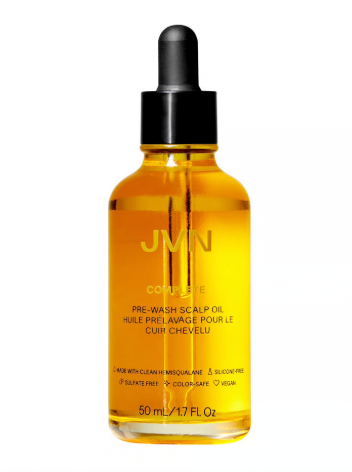
Oiling
Even if your hair is prone to greasiness, like mine is, I can assure you that your scalp will likely benefit from a nourishing pre-wash oil. Simply section your hair and apply the oil directly to your scalp, massaging it in as you go. Once your scalp is suitably coated, indulge in a stimulating scalp massage to help boost circulation.
Using an oil treatment and massaging it in helps to nourish follicles and roots for stronger hair, as well as soothing the scalp before washing. On top of that, it also helps to break down any stubborn build-up ahead of cleansing. My product of choice is the JVN Pre-Wash Scalp Oil, which contains turmeric extract and neem seed oil to soothe, as well as the brand’s patented hemi-squalane ingredient to hydrate the hair itself.
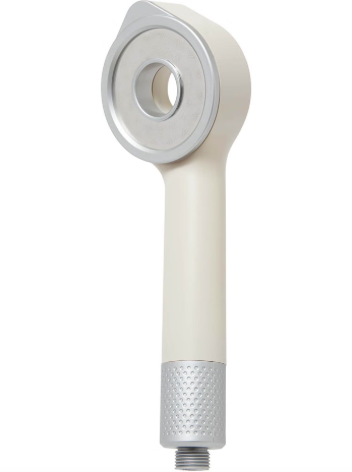
Water
Once you have left your scalp oil on for the recommended length of time (the directions for your chosen product will stipulate how long it should be left on for), it’s time to start the next step – cleansing. Before we get into that, however, I want to mention one product that has really helped improve the condition of my hair.
If, like me, you live in an area that has hard water, you might benefit from a purifying shower filter. Hard water contains a higher amount of minerals (like calcium and chlorine) that can turn both scalp and hair dry. Since I installed the Hello Klean Purifying Shower Head to purify my shower water (and filter out any excess of that hard-water mineral build-up) my scalp and hair have been happier than ever.
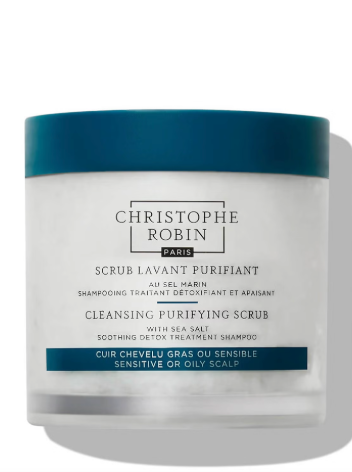
Cleansing
When it comes to cleansing, the product you choose totally depends on the condition of your scalp. However, as a part of your weekly scalp facial, I do recommend using an exfoliating shampoo or cleansing product.
If, like me, you have thinner hair, you might enjoy using a scrub to rid the scalp of any build-up. I adore the Christophe Robin Cleansing Purifying Scrub. To start, it soothes itching while the inclusion of sea salt delivers a super-deep clean and boosts circulation, but beyond that it also develops into an unctuous lather that feels really luxurious.
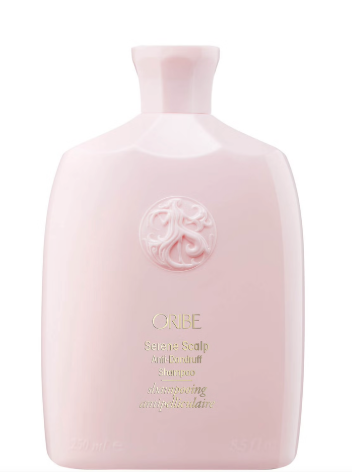
Cleansing
When it comes to cleansing, the product you choose totally depends on the condition of your scalp. However, as a part of your weekly scalp facial, I do recommend using an exfoliating shampoo or cleansing product.
If your hair is thick and/or curly, you might find scalp scrubs too laborious and hard to rinse out. If that is the case, you will likely benefit more from an exfoliating shampoo that contains salicylic acid. Oribe Serene Scalp Balancing Shampoo gently exfoliates to rid the scalp of any build-up and flakes, but is hydrating enough that it still delivers notable soothing relief.

Massage
Once you have applied your chosen cleanser in the shower, before you rinse it out, now is the time to indulge in a scalp massage. Massaging in your cleanser will ensure your scalp is truly rid of any irritation-causing build-up and it helps soothe the mind and boost circulation while it’s at it.
Incorporating a scalp brush is the easiest and most effective way to achieve the ultimate at-home scalp massage. I simply swirl the Straand Exfoliating Scalp Brush around my scalp for 30 seconds and revel in the joy of it all.
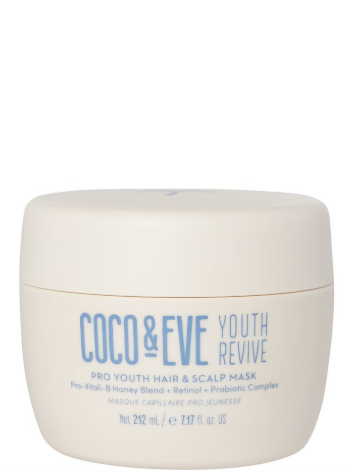
Mask
Once you have sufficiently rinsed out your cleanser, it’s time to move onto the conditioning stage in the form of a scalp and hair mask.While most hair conditioners and masks aren’t formulated to be applied to the scalp, there are some products out there which cater to both needs, so be sure you’re using a product that clearly states it can be applied to the scalp. My mask of choice is the Coco & Eve Youth Revive Pro Youth Hair and Scalp Mask, containing retinol and pre and post biotics to help cleanse, nourish and balance the skin on the scalp, as well as nourishing coconut oil and honey to condition hair.
Once you have slathered your mask from root to tip, let it sit. It is at this stage that I like to step out of the water and crank up the heat to create a steamy delight. (Steam helps the mask to better penetrate the hair and also aids in unclogging follicles.) When the time is up, rinse both your scalp and hair thoroughly.
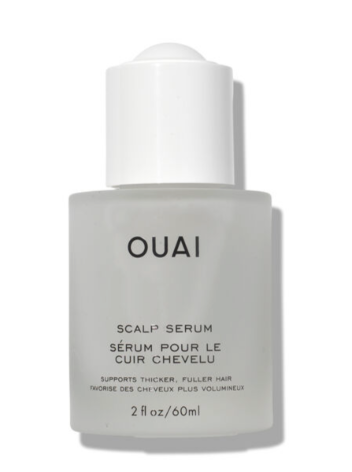
Serum or Treatment
This is the leave-on ‘skincare’ stage of your scalp facial. After you have stepped out of the shower, towel dry your hair and apply a scalp treatment. Again, there are heaps of different formulas out there for different wants and needs.
If you are simply looking to maintain scalp health, you might be interested in Ouai’s Scalp Serum, which is made for all hair types and simply works to hydrate, balance and soothe. However, if like me, you long for fuller-looking hair, you might like to go for a thickening treatment or serum. Virtue Flourish Density Booster contains peptides and prebiotics specifically formulated to cleanse and enrich the scalp, promoting healthier hair growth. Plus, it contains Virtue’s iconic Alpha Keratin 60ku complex to help repair damage in the strands, fending off breakage.
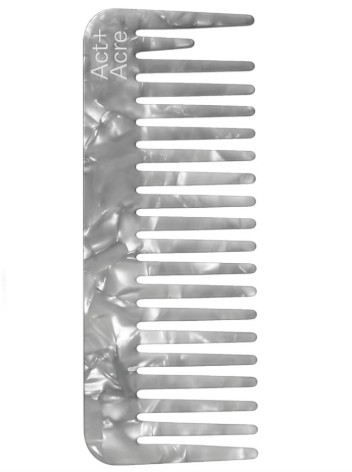
Combing and Brushing
Speaking of breakage, if you’re noticing hair fall as a result of breakage, it could be time to switch up your brush. For my scalp facials, I enjoy using a wide-toothed comb that minimises pulling and snapping, like Act + Acre Detangling Hair Comb. Our hair is at its most fragile when it is wet, so it’s important not tug on the hair while brushing it out post-shower, instead starting from the ends and working your way up to the root.
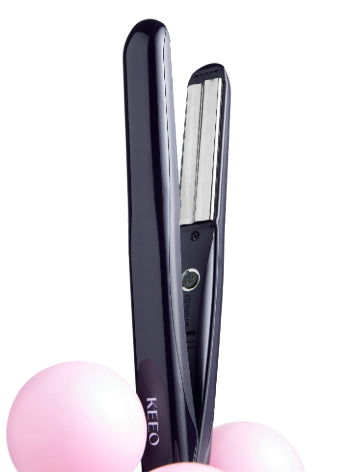
Styling
Once your post-scalp-facial hair has been blow-dried (with a heat protector, please), it’s time to style it.In order to reap the benefits of your scalp facial as much as possible, it’s important that you don’t undo all of your hard work by damaging the hair shafts with extreme heat or pulling at the root and weakening the hair follicle – both of which can lead to breakage and fall. If you’re after smooth, glossy lengths, The KEEO Genius Styler utilises contoured plates and a Protective Air Gap to smooth the hair cuticle without excessive heat damage or tugging, delivering up to 50% less tension, making it the ultimate styling tool to finish off your scalp facial.